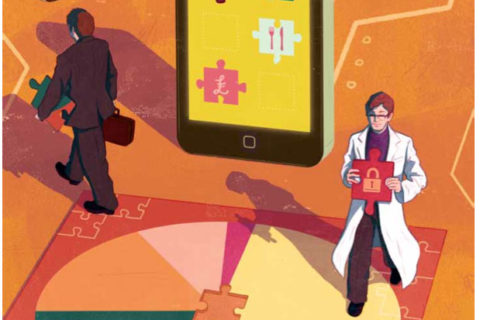We’re in the home stretch now at ESOMAR’s 3D Digital Dimensions 2012 conference. The delegates have had their lunch, grabbed a coffee and about to get stuck into this afternoon’s session.
Third Dimension: Mobile Research Fast Track.
A series of 15 minute presentations as opposed to the usual 20 minutes. We kicked off, after a short introduction from Mike Cooke, with Research in the Mobile Mindset with Anouk Willems and Annelies Verhaeghe of Insites Consulting in Belgium. These days no environment is 100% mobile free anywhere. InSites wanted to explore this mobile world, using several studies to better understand mobile research.
Firstly they introduced a a case study in which they endeavoured to study in-shop behaviour of consumers in two retail stores in Belgium. Using QR code and links they allowed consumers in the stores to take part in a short surveys. They found they had less control on recruitment of respondents, it was very shop dependent. But found they had less waste than traditional panels and client databases. When it came to representativity they found that the social demographics were off-whack with increased youth respondents and consumers that were already brand fans and more engagement with the brand. When it came to drilling deeper into the heat-of-moment research they found during the shopping trip consumers were more positive in the shop that out, they also found that negative experiences were sometime forgotten once some time has passed.
In a further study InSites looked onto engagement in MROCs, they created a mobile app for an Australian food community. They found members were able to follow and join the same discussions at any time. It increased engagement and in some cases increased the input from members of the community. But what about the data the respondents are leaving, on a mobile do they write less? Well Anouk and the team discovered that although members don’t post more or less, they post more contextual and personal data. The duality if mobile and desktop provides increased engagement and richer contributions.
Moving on we had more research on research with Christian Dubreuil of Research Now in the UK and Sally Joubert of Luma Research in Australia who presented Research in the Mobile Mindset. The two agencies had joined in a study to look at the quality of insights gained from mobile compared to desktop when it came of advertising research. They wanted to explore the feasibility, practicality, reliability and value of mobile ad testing. Using two metrics of attention and bonding to brand. They wanted to know whether screen-time, time of day etc had differences in results. In phase 1 of the study, using 2 identical demographic pools of respondents they found that 56% of smartphone respondents completed the survey out of working hours compared to 21% of desktop respondents. They also found that in terms of brand bonding they recorded almost exactly the same between mobile and desktop. But when it came to attention scores in mobile were lower than desktop.
This led to phase 2 of the study, which included an opt-in passive data collection. The team experienced the same consistency or lack of consistency in down-time completion and brand bonding. But this time they also found consistent attention between the 2 platforms. It appears that for this study it screen size was not an issue. Sally concluded that mobile research shows some encouraging consistencies with the more traditional desktop panels, but we need to think about the survey we are offering and what we give back to the respondent.
Moving swiftly on we were joined by Misha Tsvelik to talk about a recent study from EasyInsites in the UK with his presentation Device Diversity. Recently EasyInsites found that 44% of their panellists would prefer to answer surveys on a smartphone or tablet, so they wanted to explore this further and the quality of data that can be leveraged through mobile research and differences that arise through survey design. In a study that split respondents into pools to answer surveys on smartphones, tablets and desktops. Each was given a survey that was either optimised for the device or optimised for a different device. On mobile devices respondents seemed more engaged when it had been optimised for the device, but they also found that there were no differences in the answer itself if it required further scrolling on mobile device. In general Misha found that on an optimised mobile data quality does not suffer and respondents have a higher satisfaction, but LOI does increase compared to desktop. On surveys that were not optimised for the device they found it excludes certain segments of respondents due to drop out, leads to further LOI increases and a lower satisfaction.
Without even a breath to stretch my fingers we were straight on to the final fast track session. Navin Williams of MobileMeasure in China and the Impact of 3D Objects in Mobile Market Research. Navin was here to talk about augmented reality, a concept that is seeing increased use in mobile consumer apps, but that has yet to be embraced by the research industry. He presented a recent project created by MobileMeasure where an app could be downloaded by the respondent, once downloaded there was a short introduction making clear the expectation of what was needed from users. Once this was done the respondent had to complete a task in 3D on the screen, moving objects around a virtual space. With this experience Navin found that the quality and creativity in production makes a difference, while use of the camera and augmented reality enhanced the research experience. However, the cost in producing such apps is very expensive and production time is very high.
After the last coffee break of this conference we entered the last session of 3D Digital Dimensions. First up was Francesco D’Orazio of Face in UK who was looking at the explosion in the sensors and the Future Mobile Research – Mining Reality through the mobile phone. Francesco started with some background; Social media made online behaviour measurable, now sensors are doing the same with reality. Sensors now record everything and machine sensing is changing a number of disciplines. By 2015 a single smart phone will host 20 sensors and with over 1 billion smartphones on the planet the opportunities for research is clear, but according to Francesco we need to catch up, there is a huge gap between what can be done and what we’re doing. Francesco then walked us through a recent project in which Face looked to tap into some of the sensors that can be found on any iPhone. In this project Face provided the respondent with a mission, get to a specific location at a specific time, using the camera to collect images of aspects that helped you get to your destination. They could then pull all the photos together and use of 13 sensors on the smartphone to create the full story of the journey.
Using data like this allows to take spatial date. Identify significant locations, hesitation at entrances, cue effectiveness, re-negotiation and how we manage uncertainty. Francesco left us by saying we can get such rich data from the use of sensors that a huge amount of people carry around with them all day – Physical and social context, behavioural profile and quantitative validation. Behaviours not claims, frictionless data. But the analysis still too complex, the opportunity is massive but we need to catch up with the computational science.
It was up to gamification guru and author Gabe Zichermann to lead us out of this year’s conference with the closing keynote looking at How Gamification Will Transform Research. Gabe started with a look at intelligence, he talked of fluid intelligence, the type of smarts that helps with our ability to think our way out of problems. It is the human characteristic most related to innovation, and it’s something you can increase by doing the following:
- Seek novelty
- Challenge yourself
- Think creatively
- Do things the hard way
- Network
These are all characteristics involved in modern day computer games. Gabe went on to explain that we’re at a major gulf between generations, which has been brought on by the younger generations use of games over a long period of time. The youth of today are nothing like their parents, they will not be able to sit through 45 minute lecture without checking their phones or do a job without constant positive feedback. But it’s not their problem, Gabe says, it’s our world that is too slow. Gabe went on to explain why this is. Every time we challenge ourself and achieve something our brain releases dopamine. Challenge, achievement, pleasure. Outside of games, how often can you get this loop? Occasionally at best. In the world of games this loop is provided 100s of times an hour. This has caused a fundamental shift in the younger generation.
But gamification is not just throwing badges onto a website. Nor is it about turning everything into a game. You need to take the best ideas from games, the mechanics of games and apply them to particular problems. And what makes games compelling?
- Feedback
- Friends
- Fun
We were provided with a number of examples as to how ramification has been used in the real world to achieve positive results. Speed Cameras in Sweden, protein folding games that help discover vital proteins, Q&A websites that allow you to pose questions to some of top software developers in the world for free. technical software questions, top software developers who answer questions for free for nothing but status amongst peers and the use of Monopoly in helping educate children in failing schools. Recognition and status is vital in gamification, but no matter how good a game is, if it’s forced it won’t be much fun. When thinking about design you need to consider craveability.
Finally Gabe talked about incentives, researchers have gone down the wrong road by giving money to respondents. There is a set of rewards that users are looking and right at the bottom of the pile is money. In order, what user are looking are:
- Status
- Access
- Power
- Stuff
Over reliance of researchers on material incentives creates a bias by using people that need the money. When you use status, access and power it attracts both the rich and the poor.
With that ESOMAR’s 3D Digital Dimensions 2012 conference came to end, it was only left to ESOMAR Council member Pravin Shekar to present the conference awards. With best paper nomination going to Socialising Research by Michael Rodenburgh of Ipsos Open Thinking Exchange in Canada, and best presentation award handed to Anouk Willems and Annelies Verhaeghe of InSites Consulting in Belgium.
And that’s it from me, until war start again tomorrow with ESOMAR’s Qualitative 2012 conference.


